With the booming development of the new energy vehicle industry, new energy vehicle power batteries have become the core components that determine vehicle performance and life. Balanced maintenance of power batteries can not only extend service life, but also improve safety and efficiency. This article will introduce you to 5 key strategies to help you optimize battery performance and recommend professional technical support from Guheng Energy.
The importance of new energy vehicle power batteries
New energy vehicle power batteryIt is the heart of electric vehicles, directly affecting the driving range, acceleration performance and user experience. It usually adopts lithium battery technology, which has the characteristics of high energy density and long life. However, the battery pack is composed of multiple monomers. If there is a lack of balanced maintenance, it will lead to inconsistent performance and even cause failure.
The core role of power batteries
- Energy supply: Provide continuous power for the vehicle.
- System stability: Affects the operation of the vehicle control system.
- Safety and security:Battery health status is related to driving safety.
Data shows that the capacity of a battery pack without balanced maintenance can decay by 20% within 2 years, while this ratio can be controlled within 5% through scientific maintenance.New Energy Vehicle Solutions.
Power battery balancing maintenance strategy 1: regular inspection and monitoring
Regular inspection is the basis for maintaining new energy vehicle power batteries. By monitoring the battery status, single cell differences and potential problems can be discovered in a timely manner.
Check points
- Voltage monitoring: Ensure that the voltage of each monomer is consistent and the deviation does not exceed 50mV.
- Capacity detection:Evaluate the gap between the actual battery capacity and the nominal value.
- Internal resistance measurement: Abnormal internal resistance may be a sign of aging.
Using solid energyPortable battery pack balance maintenance instrument PBM-PW-B-2405, which can achieve accurate monitoring and quickly identify problematic batteries.

Power battery balancing maintenance strategy 2: Optimizing charge and discharge management
Charge and discharge management directly affects the balance of new energy vehicle power batteries. Optimizing charging strategies can reduce performance differences between cells.
Optimization Methods
- Slow charging priority: Use low current charging to reduce battery overheating.
- Equalizing Charge: Use BMS (battery management system) to balance the single cell voltage.
- Avoid overdischarge: Keep the battery charge between 20% and 80% to avoid deep discharge.
For example, properly setting the charging time can extend the battery life to more than 8 years. Combined with professional equipment, such asPortable Battery Balance Maintenance Instrument-PBM-PW-F-3205, the effect is better.

Power battery balancing maintenance strategy three: application of thermal management system
Temperature is a key factor affecting the performance of new energy vehicle power batteries. The thermal management system can effectively maintain the battery operating within an appropriate temperature range.
The Importance of Thermal Management
- High temperature protection: Overheating can lead to capacity fade and safety risks.
- Low temperature optimization: At low temperatures, the internal resistance of the battery increases and the charging efficiency decreases.
Implementation
| method | effect | Applicable scenarios |
| Liquid Cooling System | Rapid heat dissipation and uniform temperature | High-performance electric vehicles |
| Air cooling system | Low cost and simple maintenance | Economy Model |
| Heating module | Improve low temperature charging efficiency | Vehicles in cold regions |
Through thermal management, the battery operating temperature can be stabilized at 20-40°C, extending the battery life by about 30%.
Power battery balancing maintenance strategy 4: regular software upgrades and calibration
Software upgrade and calibration of battery management system is very important for new energy vehicle power battery. It can optimize the balancing algorithm and improve the diagnostic accuracy.
Benefits of Upgrading and Calibration
- Accurate data: Calibrate SOC (state of charge) to avoid battery life display errors.
- Balance Enhancement: Update the algorithm to balance the cell voltage and capacity.
- Fault warning:Detect anomalies in advance and improve safety.
It is recommended to perform a software check every 6 months, especially after the battery has been used for 2 years, the effect will be more significant.
Power battery equalization maintenance strategy 5: Choose reliable technical service experts
Professional technical support is the guarantee for the maintenance of new energy vehicle power batteries. Choose an experienced service provider who can provide customized solutions.
How to choose a service expert
- Technical Strength: Equipped with professional equipment for battery testing and maintenance.
- Service Experience: Familiar with the characteristics of new energy vehicle batteries.
- Response speed: Provide fast technical support and after-sales.
Solid EnergyPortable battery pack balance maintenance instrument PBM-PW-B-6405Combined with expert services, it provides comprehensive protection for battery balancing.

Guheng Energy: Your New Energy Service Technology Solution Expert
In power battery maintenance, Guheng Energy (Hangzhou Guheng Energy Technology Co., Ltd.) is your ideal partner.
Company Profile and Technical Strength
Solid EnergyFounded in 2015 and headquartered in Hangzhou, the company brings together experts in the new energy field and focuses on the research and development of battery testing and maintenance technologies. Its products include portable equalization maintenance instruments and comprehensive test systems, which are widely used in new energy vehicles and other fields.
Development History and Achievements
Guheng Energy launched its first battery tester in 2016, achieved mass production in 2018, and entered the international market in 2020. The company has many patents, its products have passed ISO9001 certification, and are deeply trusted by customers.
Technical Support and Services
Guheng Energy provides the following support:
- Customized solutions: Design a maintenance plan based on battery type.
- Professional Training: Guide users to operate balanced maintenance equipment.
- After-sales service: 7×24 hours response to ensure worry-free use.
accessGuheng Energy official website, get more technical support.
Summary and suggestions
Through the above five strategies, the balanced maintenance of new energy vehicle power batteries will be more efficient. Regular inspection, optimized management, thermal control, software upgrades and technical support complement each other to ensure battery performance and safety.
Practical advice
- Make a plan: Check the battery status once a quarter.
- Recording Data: Create a battery health profile for easy tracking.
- Professional assistance: Cooperate with Guheng Energy to improve maintenance results.
FAQ
1. How to determine whether the power battery needs balanced maintenance?
To determine whether the power battery needs balanced maintenance, the following indicators should be paid attention to:
- Voltage difference:The cell voltage deviation exceeds 50mV, indicating that the balance is reduced.
- Inconsistent capacity:The capacity of some monomers is more than 10% lower than the average value.
- Abnormal operation: Such as a sudden reduction in battery life or an increase in charging time.
It is recommended to use professional equipment for testing, such as Guheng Energy’s balance maintenance instrument, and combine it with BMS data analysis.
2. How often should power battery balancing maintenance be performed?
Maintenance frequency varies depending on the intensity of use:
- Daily use vehicle: It is recommended to perform balancing maintenance every 6 months to check the status of the cells.
- High-intensity use (such as taxis): Once every 3 months to ensure stable performance.
- Abnormal situations: If overheating or abnormal battery life is found, perform maintenance immediately.
Regular maintenance can extend battery life by 20%-30%.
3. How much impact does the thermal management system have on the life of power batteries?
Thermal management system has a significant impact on battery life:
- High temperature control: When the temperature exceeds 45°C, the service life is halved for every 10°C increase.
- Low temperature optimization: Charging below 0°C will damage the battery structure and reduce capacity.
- Ideal range: Maintaining 20-40°C can extend the service life to 8-10 years.
Data shows that the battery attenuation rate of batteries equipped with thermal management is only 1/3 of that of batteries without thermal management.





